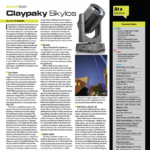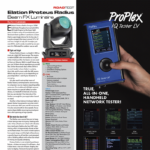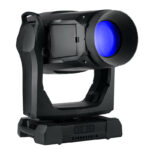There are four separate LED cells on the fixture, but instead of being butted up against each other, they are separated by about five inches of space, forming a square shape of four separated bulbs. But the light itself is not square. To the eye, it resembles a pair of Mickey Mouse ears butted up at the base. And I say that in a good way.
The cells are attached to a cast aluminum alloy structure that can best be described as an ergonomic art piece. Its smooth physical curves remind me of Gumby, the old Claymation character. The shell is covered in a black rubberized paint that adds a soft feel and protective coating. Mounted to the back is a permanent yoke with two tee-handles for focusing. The yoke makes it easy to stand by itself or attach a clamp of your choice. There are literally no hard angles on this fixture, yet it is one sturdy piece of gear.
Warm Tungsten Glow
Each cell of the fixture emits a powerful wide beam of warm white light. The color temperature is a warm 3100° K, matching that of a tungsten fixture. The light source in each cell is a 100W COB (Chip On Board) LED. The COB element sits in a reflector and is covered with a stipple lens. This is the only lens option. They claim the beam angle for each cell is 49°. I notice that when I focus each cell straight ahead, I have an estimated 90° coverage.
Each of the four cells is mounted in a round holder that can individually pan left or right manually. They stay in place once focused. I wonder to myself why I cannot tilt them as well. There is a degree indicator on the side, so you can match all the cell directions to the same angle. They pivot 24° either side of center. When the lights are either crossed inwards or spread outwards, I am watching one fixture cover about 130° to my eye. That’s a big field. You could use these lights in place of scoops at a convention and save yourself a fortune in dimmers, power and time.
To call them bright is an understatement. It hurts to look directly into the light source from 20 feet away. I measure a light output of 620 lux with all four cells at full from that 20-foot distance. A single cell meters about 160 lux by itself. If you are looking to burn some retinas and melt some faces — this is the light for you.
Control Options
The software is the key in these beauties. There are several personalities one can use, dependent on the number of DMX channels you wish to use. There are also three distinctly different dimmer curves one can use. I set it up first as a single-channel fixture, where one channel controls the output of all four cells.
The lamp fades up and down perfectly, like a tungsten lamp on a good dimmer. I can bump it on and off instantly, like any LED. I change to dimmer curve two. I see more of a ramping motion when I bring it up and down, similar to a rock ‘n’ roll PAR can. Finally I take a look at dimmer curve three. Now the fixture is acting just like a DWE bulb in a Mole light. It flashes on a tad slower than an LED, and when you let go of the flash button, it takes a full second to fade out, just like any old Mole.
I move on and set it in a 3-channel mode. This adds a strobe channel into the light. Taking that channel from 0-50 percent brings on different speeds of an in-sync strobe from all four cells. Once past 51 percent, there are all kinds of random strobe rates between the cells. I move on to four-channel mode. This mode gives me individual intensity control of each cell. I write a dimmer chase and can make these things pretty much strobe.
I step up and put the fixture in full 9-channel extended mode. This is the proper mode to run these bad boys in, because you have all the bells and whistles. Channel 1 is like a Grand Master for the fixture. I now have individual control of all four cells through their channels, but no light will emit from the fixture until the first channel is at full. One might think this is silly, but once I move on with the test, I get the reasoning, and it’s brilliant.
I still have a strobe channel that acts the same as the other mode. But I now have another channel full of macros containing all sorts of pre-canned effects. As I scroll through the effects channel, I see several cool chases and blinking eye candy effects. Various speeds of these effects are there, in ranges of DMX. No matter what pulsing effect or chase I enable, I can override the intensity of the output through the dimmer channel.
Lastly, in full channel mode, I notice I have a separate channel that can be used to change the dimmer curve from the console. This way, the fixture can act like an old tungsten Mole for one song, then be popping like an LED eye-candy light the next.
Small Footprint
Physically, the fixture is heavy, at 19 pounds, but considering the electronic dimming and brains are inside it, that’s not bad. The 14-inch square footprint it takes up is small. I see these fixtures tucked into stage sets as well as display windows. Powered up through an Edison-to-Neutrik connector, it can self-sense between 100V and 240V AC. Running at full intensity on 120V, the fixture draws a measly 2.5 amps. That’s about one-tenth of a tungsten 4-lighter. It’s rated IP20, so keep it in a dry location. Barely any heat comes out of the front at full intensity, but it has an auto fan or permanent fan setting to ensure the inside stays cool. For camera use, this model offers various PWM frequency settings to ensure flicker-free operation.
At a Glance
Four-Eyed Blinder
With its smooth curves and distinctive looks, Chauvet’s Strike 4 blinder has rounded design features that could be described as whimsical or sexy. But with its intense output, the Strike 4 is ready for serious business, delivering a warm tungsten glow that can cover a broad field with individual LED cells that can pan 24° on either side of center.
Chauvet Strike 4
PROS:
Unique shape, perfect dimming options, good macros, low power draw, great output.
CONS:
Inability to focus each cell in every direction.
Features:
- Automated pulse effects
- 16-bit dimming control
- Works as wash or strobe
- Individual pan control (24° from center)
- Adjustable PWM for flicker control
STATS:
Size: Square; 14” per side
Weight: 19 lbs.
MSRP: $1,329.99
SPECS:
LEDs: Four 100W COB LEDs
Output: 640 Lux @ 5m
Color Temp: 3100° K
Power: 100V-240V AC (self-sensing)
Price: $1,329.99 (MSRP)
More Info: www.chauvetlighting.com



